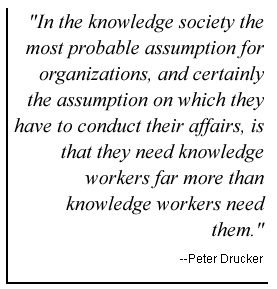- that the federal government is the nation's largest employer of
college graduates, professionals, and technical experts—a
knowledge-intensive enterprise even more dependent on its
knowledge workers than is corporate America; and

- that, as Thomas A. Stewart notes in Fortune magazine, "[This is] the age of intellectual capital, and the most valuable parts of jobs are the human tasks: sensing, judging, creating, building relationships."1
How are you managing for results in the face of these challenges? How are you making sure you get the requisite brain power for the results you need? And how do you do this while you struggle to do more with less?
The answer does not lie in finding more money or making more time for training. And it's not about recruiting the best and brightest. These are not realistic alternatives for the government manager — nor are they necessary.
This handbook shows managers how to transcend these narrow views and discover a new world of rapid, low-cost or no-cost ways to build a smarter workforce and keep it that way. For, as Thomas Stewart writes, "Intelligence, like any asset, needs to be cultivated in the context of the action. Random hiring of Ph.D.s won't cut it."2
In this handbook, you will find many steps you can take on your own to get results through learning. You will discover how to build new social forms of learning, and amass and concentrate human capital where it is needed. You will also find out about the services and support managers can and should expect from federal human resource development (HRD) offices.
Training professionals in these HRD offices should also read this handbook in order to get a better appreciation of the learning-related needs and expectations of managers. As the practitioners of HRD for the federal workforce, they need to be able to provide expert consultation to managers, anticipate managers' performance requirements, and help managers achieve results.
Recent data show that learning in the workplace is the single most important contribution to improving productivity. Government managers and HRD practitioners have the power to get results through learning by adopting the practices in this handbook and focusing on the business objectives of their organization.
There will never be a more opportune moment than now to begin this effort; the demands of the workplace will only continue to escalate. Daryl Conner puts this moment into perspective in Managing at the Speed of Change: "You have more control and less ambiguity today than you are likely to have for the rest of your life."3